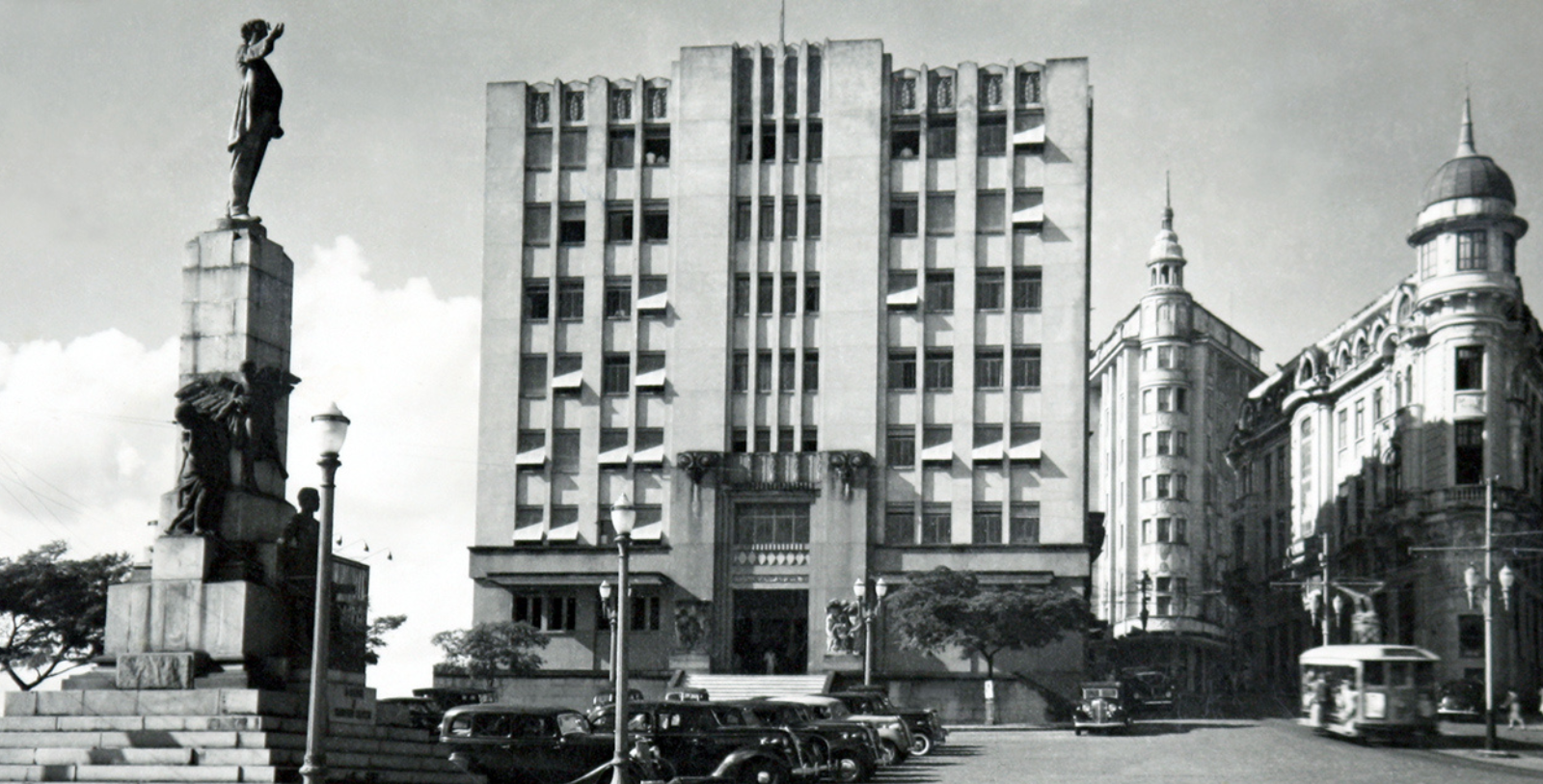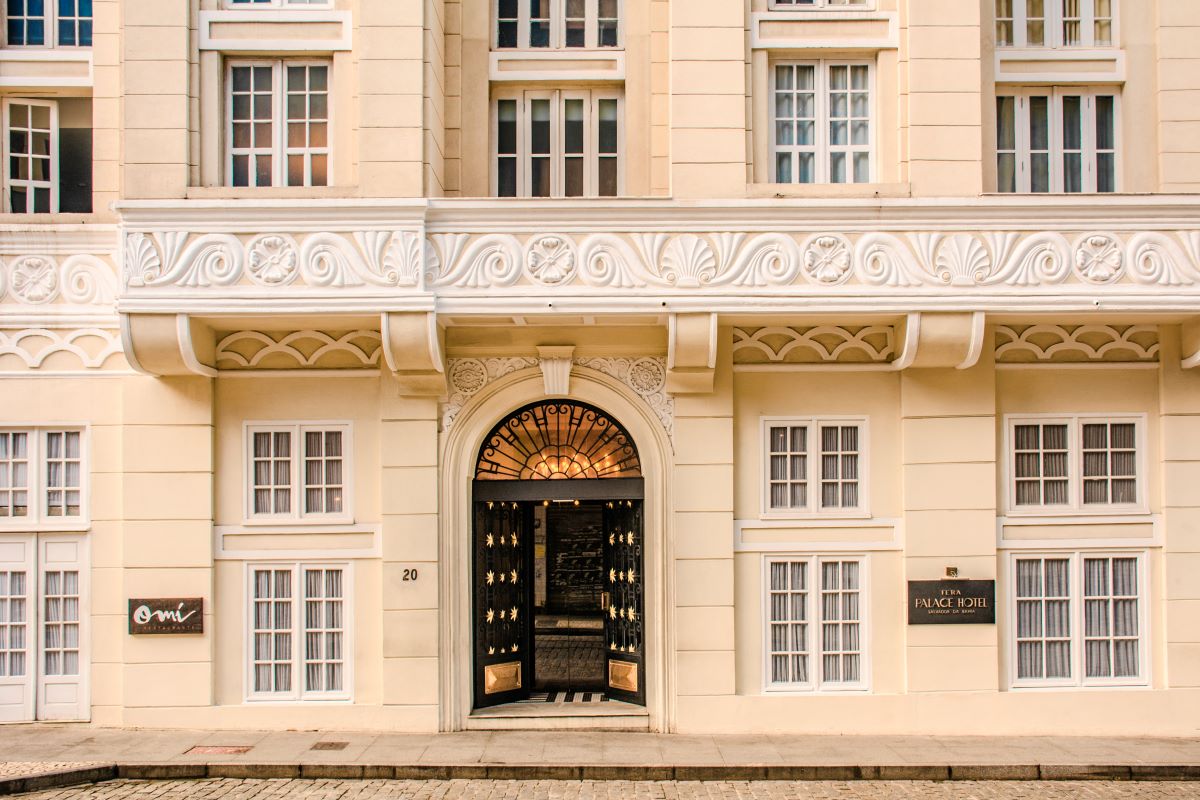Receive for Free - Discover & Explore eNewsletter monthly with advance notice of special offers, packages, and insider savings from 10% - 30% off Best Available Rates at selected hotels.
history
Discover Fera Palace Hotel, which has been among the choice destination for travelers arriving to Brazil’s Bahia state since the 1930s.
Fera Palace Hotel, a member of Historic Hotels Worldwide since 2023, dates back to 1934.
VIEW TIMELINEIn the 1930s, the city of Salvador in the Brazilian state of Bahia was quickly emerging as one of the most vibrant communities in the Americas. Central to the city’s cultural renaissance was Rua Chile, an ancient thoroughfare that dates back to the city’s founding during the 16th century. Bisecting Salvador’s historic downtown core, Rua Chile had become home to dozens of upscale storefronts that sold a variety of fine goods ranging from rare fabrics to Chinese porcelain. Visitor traffic along the street increased steadily, spawning many other businesses like restaurants, nightclubs, and concert halls. A few hoteliers thus decided to construct a magnificent boutique hotel on Rua Chile in light of those socioeconomic developments. Sparing no expense, the group endeavored to erect a building that would cater to the preferences of the contemporary travelers flocking to the area. The hoteliers opted to use the motifs of the then-prevalent Art Deco architecture to craft the structure’s sleek appearance. The hotel subsequently displayed a rich combination of geometric decorations throughout its gorgeous façade that brilliantly highlighted its modern character. But the architects leading the project also relied on inspiration from other renowned structures located around the world. Perhaps the most stunning feature borrowed and incorporated within the overall design was the hotel’s triangular foundation, which had been based closely on the celebrated Flatiron Building in Manhattan. When the building finally debuted as the “Palace Hotel” in 1934, it immediately became one of the most exciting social gathering spots in all Bahia. Indeed, the hotel emerged as a popular place for holding impromptu musical performances, giving the site an enviable reputation for thrillingly memorable experiences.
Countless guests were soon reserving every available guestroom inside the Palace Hotel in order to participate in the rich activities frequently taking place on-site. Furthermore, the hotel also served as a waypoint for travelers eager to explore the fantastic nightlife of Rua Chile, as well as the greater Afro-Brazilian culture that defined the community. In fact, the building eventually hosted many illustrious figures who had come to discover Salvador’s heritage, including Orson Welles, Carmen Miranda, and Pablo Neruda. But the shoppoing district shifted toward the other side of town, which siphoned clientele from the Palace Hotel. The loss of business grew to be too great, forcing the hotel to close permanently during the 1980s. Now vacant, the structure fell into a state of dilapidation over the next several decades. However, the historic hotel received a new lease of life when Antonio Mazzafera purchased the location in 2012. Intent on saving the venerable structure, Mazzafera soon commissioned a major renovation that completely revitalized it. The work proved to be an incredible endeavor, taking three years to finish. What Mazzafera and his team had managed to accomplish was nothing short of spectacular. They had installed an extensive array of plumbing and electrical fixtures, while also providing much-needed reinforcement to the building’s structural frame. A comprehensive restoration to the exterior had also transpired that successfully revived its marvelous historic architecture back to its former glory. In the end, Mazzafera had masterfully resurrected the building as the “Fera Palace Hotel,” which opened to great acclaim in 2017. The Fera Palace Hotel has since resumed being one of the area’s best holiday destinations, offering unrivaled hospitality and timeless elegance to its patrons.
-
About the Location +
Located in the distinctive Brazilian state of Bahia, Salvador is one of the most culturally unique communities in the country today. Its fascinating character largely stems from its history, having been founded generations ago during the 16th century. Those early settlers specifically arrived following a long journey from Portugal in the late 1540s. The colonists themselves were under the leadership of Brazil’s first colonial governor, Tomé de Sous, who had been charged by the Portuguese monarch to establish an overseas colony in the area. While prior attempts at founding a settlement had failed, Tomé de Sous nonetheless accepted the assignment eagerly. He took a particular interest in the site of present-day Bahia, for it resided next to a natural harbor referred to as “Todos os Santos Bay,” or “Bay of All Saints.” (Famous Italian explorer Amerigo Vespucci had originally chosen the name years earlier, gaining inspiration from the fact that he had sailed into the body of water on All Saints’ Day.) In 1549, Sous and his fellow Portuguese settlers proceeded to erect the street grid upon a cliff that overlooked the bay. But the geography presented itself to be a challenge, with a 279-foot-high escarpment splitting the construction site right down the middle. To remedy the situation, the colonists ultimately divided the nascent city into two regions: the upper and lower districts. The upper area dominated the skyline, hosting the city’s important religious and administrative buildings, as well as most of the residences. Meanwhile, the colonists developed the bottom half of the city to feature the commercial structures, including the wharves.
Known formally as “São Salvador da Bahia de Todos os Santos,” the new city of Salvador quickly became the most important community in Brazil for the next two centuries. Tomé de Sous and his predecessors kept the colonial capital at Salvador until 1763, while the Roman Catholic Church used it to act as the site for the first Brazilian diocese. In fact, the congregation even attained the status of an archdiocese in the 17th century, eventually becoming the premier see for Brazil. The community was also economically prosperous, for its harbor functioned as the main port of entry for the whole colony. While the presence of industry inside Salvador remained scarce, the settlement’s proximity to an ever-growing number of sugarcane plantations made it invaluable to countless Portuguese planters. Salvador thus thrived on merchant shipping, with hundreds of ships exporting sugar to markets back in Portugal. However, Salvador’s prosperity came at a price, as foreign navies began targeting the port during times of war. (A Dutch fleet managed to capture Salvador following a pitched battle in 1624, for instance, although its control over the city was brief.) Furthermore, the city’s economic success was increasingly fueled by the transatlantic slave trade. Salvador specifically emerged as the primary place where thousands of African slaves disembarked before traveling further inland to work on the sugarcane plantations. Their presence introduced new cultural practices though, which gradually changed Salvador’s communal identity to possess a variety of European and African influences.
By the time of Brazil’s independence in 1822, Salvador itself had lost much of its economic luster. Nevertheless, many residents attempted to introduce modern infrastructure to portions of the city, starting first with a powerful hydraulic elevator that better connected its two sections. Railroads and streetcars then followed, along with numerous types of heavy industry. More people began to settle in Salvador as such, enlarging its size exponentially. Afro-Brazilians constituted a majority of the migrants, particularly in the wake of slavery’s abolition throughout Brazil during the late 19th century. Salvador has since reemerged as one of Brazil’s most prosperous communities, serving as home to manufacturing operations like textiles, chemical compounds, and automobile parts. The port itself remains incredibly important to Salvador, which currently services many international cruise lines and other recreational vessels. Much of Salvador’s present appeal is its rich identity, especially the strong Afro-Brazilian cultural connections that define the city today. The Pelourinho—the historic city center—is also a major attraction among contemporary travelers, forming the nucleus to Salvador’s cherished UNESCO World Heritage Site. Indeed, the city’s downtown core is often hailed by scholars for its wonderfully preserved colonial structures that date back centuries! (Other historic landmarks that visitors have routinely explored include the Cathedral of Salvador, Igreja de Nossa Senhora do Rosário dos Pretos, Mercado Modelo, and the São Marcelo Fort.)
-
About the Architecture +
Fera Palace Hotel stands today as a brilliant example of historic Art Deco architecture. Art Deco architecture itself is among the most famous architectural styles in the world. The form originally emerged from a desire among architects to break with past precedents to find architectural inspiration from historical examples. Professionals within the field instead aspired to forge their own design principles. More importantly, they hoped that their ideas would better reflect the technological advances of the modern age. Historians today thus consider Art Deco to be a part of the much wider proliferation of cultural “Modernism” that first appeared at the dawn of the 20th century. Art Deco as a style first became popular in 1922, when Finnish architect Eliel Saarinen submitted the first blueprints to feature the form amid a contest to develop the headquarters of the Chicago Tribune. While his concepts did not win over the judges, they were widely publicized nonetheless. Architects in both North America and Europe soon raced to copy his format, giving birth to Art Deco architecture. The international embrace of Art Deco had risen so quickly that it was the central theme of the renowned Exposition des Art Decoratifs in Paris a few years later. Architects the world over soon fell in love with Art Deco’s sleek, linear appearance, coming to adore its use of geometric motifs like chevrons and zigzags. But in spite of the deep admiration people felt toward Art Deco, interest in the style gradually dissipated throughout the mid-20th century. Nevertheless, many examples of Art Deco architecture still survive in the present, with some of the best located in major international cities like London, Paris, and New York City.
-
Famous Historic Guests +
Orson Welles, film director known for such movies as Citizen Kane, Touch of Evil, and The Magnificent Ambersons.
Carmen Miranda, actress known for her roles in such films like Banana de Terra and The Gang’s All Here.
Grande Otelo, actor best remembered for the comic duo he formed with fellow performer, Oscarito.
Pablo Neruda, poet and diplomat, who once won the Nobel Prize in Literature in 1971.


























